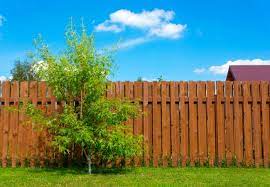A well-maintained fence can make a significant difference in protecting and beautifying your outdoor spaces. If you live in an area prone to extreme weather, such as blistering heat, freezing cold, heavy rain, or intense sun exposure, your fence may require special attention. In this blog post, we will look at the difficulties of staining a fence in different climates, particularly in extreme weather zones, and offer helpful hints on how to maintain and protect your fence. We will also briefly discuss how I Paint Stuff, a professional painting and staining company, can help you with this endeavor.
Understanding the Issues
Extreme weather can cause your fence to deteriorate, fade, or become vulnerable to damage. To stain your fence effectively and keep it looking great in harsh weather conditions, you must first understand the specific challenges posed by your climate:
- Excessive Heat: In hot climates, the sun’s rays can cause the wood to fade and dry out, making it prone to cracking and warping.
- Freezing Temperatures: Freezing temperatures in cold climates can cause the wood to contract and expand, resulting in cracks and splits in the fence.
- Heavy Rainfall: Excessive rain or high humidity can cause moisture penetration, which can lead to mold, mildew, and rot if not addressed properly.
- Intense Sun Exposure: Direct sunlight can cause the stain to break down and fade faster, necessitating more frequent re-staining.
- Windy Conditions: Strong winds can cause debris to scratch the fence’s surface, resulting in aesthetic damage.
Fence Staining Tips for Extreme Weather Zones
Now that we’ve covered the obstacles, let’s look at some helpful hints for staining and maintaining your fence in harsh weather conditions:
- Choose the Right Stain: Choosing the right fence stain is critical. Consider using a high-quality, UV-resistant stain that provides protection from both direct sunlight and moisture. Water-based stains are often recommended for colder and wetter climates, whereas oil-based stains are often recommended for hotter and drier climates.
- Prep the Surface: For a long-lasting finish, your fence must be properly prepared before staining. Cleaning the surface to remove dirt, mildew, and old stains, as well as sanding to smooth any rough spots or imperfections, are all part of the process.
- Seal the Ends: Pay special attention to the ends of your fence boards because these are the weakest points. Extra coats of stain or sealant should be applied to the ends to prevent moisture penetration and subsequent damage.
- Routine Maintenance: Routine maintenance is critical in extreme weather zones. Check your fence at least once a year for any issues that need to be addressed. This includes re-staining, sealing gaps, and repairing damage as soon as possible.
- Shade and Shelter: Provide shade or shelter for your fence whenever possible. Planting trees or installing awnings can help protect your fence from sun damage and fading.
- Use Weatherproof Hardware: To secure your fence panels, use weather-resistant hardware such as rust-resistant screws and nails. This prevents rust deterioration in wet climates.
- Proper Drainage: Make sure the area around your fence has proper drainage to avoid water pooling or standing, which can lead to rot and other moisture-related problems.
- Regular Cleaning: Clean your fence on a regular basis with a gentle detergent and a soft brush or pressure washer to remove dirt and prevent mold and mildew growth. For professional fence staining services and more tips on maintaining your fence, visit https://yourpaintingpro.com/.
Conclusion
Staining and maintaining a fence in a high-wind zone necessitates careful planning and proactive measures. Understanding the unique challenges posed by your climate, as well as following the tips outlined in this article, can help you protect and maintain your fence for years to come. For additional insights and expert guidance on fence staining and maintenance tailored to your specific needs, click here to learn more.



